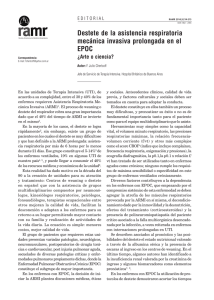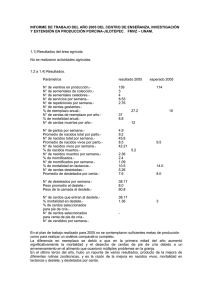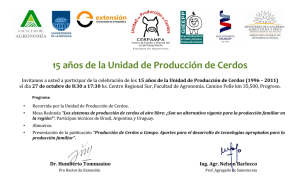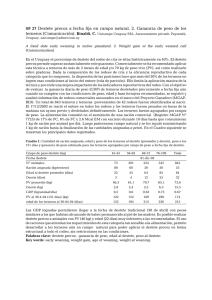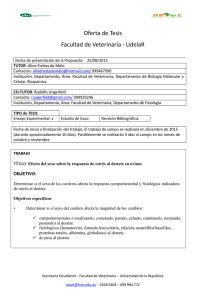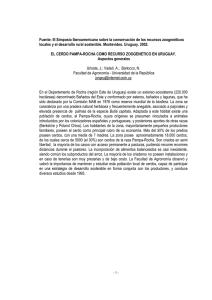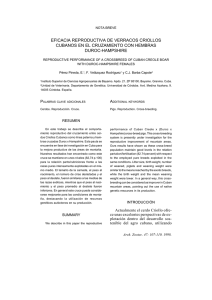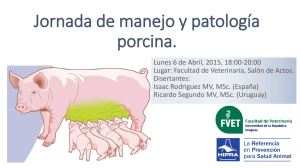Impact of IncomIng pIg QualIty on pIg performance
Anuncio
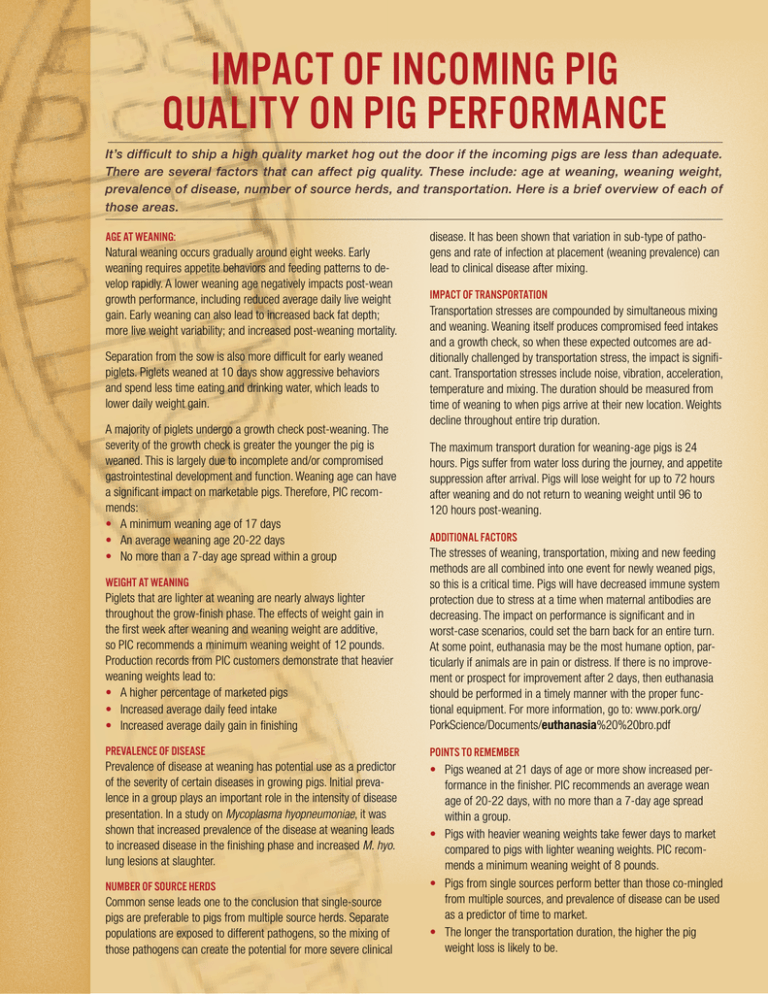
Impact of Incoming Pig Quality on Pig Performance It’s difficult to ship a high quality market hog out the door if the incoming pigs are less than adequate. There are several factors that can affect pig quality. These include: age at weaning, weaning weight, prevalence of disease, number of source herds, and transportation. Here is a brief overview of each of those areas. Age at weaning: Natural weaning occurs gradually around eight weeks. Early weaning requires appetite behaviors and feeding patterns to develop rapidly. A lower weaning age negatively impacts post-wean growth performance, including reduced average daily live weight gain. Early weaning can also lead to increased back fat depth; more live weight variability; and increased post-weaning mortality. Separation from the sow is also more difficult for early weaned piglets. Piglets weaned at 10 days show aggressive behaviors and spend less time eating and drinking water, which leads to lower daily weight gain. A majority of piglets undergo a growth check post-weaning. The severity of the growth check is greater the younger the pig is weaned. This is largely due to incomplete and/or compromised gastrointestinal development and function. Weaning age can have a significant impact on marketable pigs. Therefore, PIC recommends: • A minimum weaning age of 17 days • An average weaning age 20-22 days • No more than a 7-day age spread within a group Weight at Weaning Piglets that are lighter at weaning are nearly always lighter throughout the grow-finish phase. The effects of weight gain in the first week after weaning and weaning weight are additive, so PIC recommends a minimum weaning weight of 12 pounds. Production records from PIC customers demonstrate that heavier weaning weights lead to: • A higher percentage of marketed pigs • Increased average daily feed intake • Increased average daily gain in finishing Prevalence of Disease Prevalence of disease at weaning has potential use as a predictor of the severity of certain diseases in growing pigs. Initial prevalence in a group plays an important role in the intensity of disease presentation. In a study on Mycoplasma hyopneumoniae, it was shown that increased prevalence of the disease at weaning leads to increased disease in the finishing phase and increased M. hyo. lung lesions at slaughter. Number of Source Herds Common sense leads one to the conclusion that single-source pigs are preferable to pigs from multiple source herds. Separate populations are exposed to different pathogens, so the mixing of those pathogens can create the potential for more severe clinical disease. It has been shown that variation in sub-type of pathogens and rate of infection at placement (weaning prevalence) can lead to clinical disease after mixing. Impact of Transportation Transportation stresses are compounded by simultaneous mixing and weaning. Weaning itself produces compromised feed intakes and a growth check, so when these expected outcomes are additionally challenged by transportation stress, the impact is significant. Transportation stresses include noise, vibration, acceleration, temperature and mixing. The duration should be measured from time of weaning to when pigs arrive at their new location. Weights decline throughout entire trip duration. The maximum transport duration for weaning-age pigs is 24 hours. Pigs suffer from water loss during the journey, and appetite suppression after arrival. Pigs will lose weight for up to 72 hours after weaning and do not return to weaning weight until 96 to 120 hours post-weaning. Additional Factors The stresses of weaning, transportation, mixing and new feeding methods are all combined into one event for newly weaned pigs, so this is a critical time. Pigs will have decreased immune system protection due to stress at a time when maternal antibodies are decreasing. The impact on performance is significant and in worst-case scenarios, could set the barn back for an entire turn. At some point, euthanasia may be the most humane option, particularly if animals are in pain or distress. If there is no improvement or prospect for improvement after 2 days, then euthanasia should be performed in a timely manner with the proper functional equipment. For more information, go to: www.pork.org/ PorkScience/Documents/euthanasia%20%20bro.pdf Points to Remember • Pigs weaned at 21 days of age or more show increased performance in the finisher. PIC recommends an average wean age of 20-22 days, with no more than a 7-day age spread within a group. • Pigs with heavier weaning weights take fewer days to market compared to pigs with lighter weaning weights. PIC recommends a minimum weaning weight of 8 pounds. • Pigs from single sources perform better than those co-mingled from multiple sources, and prevalence of disease can be used as a predictor of time to market. • The longer the transportation duration, the higher the pig weight loss is likely to be. Calidad Inicial de los Cerdos y su Impacto sobre los Resultados Es difícil enviar al mercado cerdos de alta calidad si los cerdos que entran no son los adecuados. Existen varios factores que pueden afectar la calidad de los cerdos. Estos incluyen: edad al destete, peso al destete, prevalencia de enfermedades, número de fuentes de origen y transporte. Aqui tenemos una breve descripción de cada una de esas áreas. Edad al Destete: El destete natural ocurre gradualmente alrededor de las ocho semanas. Para destetar temprano se requiere desarrollar de manera rápida un comportamiento del apetito y patrones de alimentación. Una baja edad al destete impacta negativamente el crecimiento post-destete, incluyendo un bajo promedio de ganancia diaria. El destete temprano puede también llevar a un aumento en el grosor de la grasa dorsal; a mayor variabilidad del peso vivo; y a un aumento en la mortalidad post-destete. La separación de la hembra es también más difícil para cerdos destetados tempranamente. Cerdos destetados a los 10 días muestran un comportamiento agresivo y dedican menos tiempo a comer y beber agua lo cual los lleva a tener una menor ganancia diaria de peso. La mayoría de los cerdos experimentan una disminución en el crecimiento post-deste. La severidad de ésta disminución es mayor si el cerdo es destetado más temprano. Esto se debe en gran parte a un incompleto y/o comprometido desarrollo y función gastrointestinal. La edad al destete puede tener un significativo impacto sobre los cerdos comercializables. Sin embargo, PIC recomienda: • Una edad mínima de destete de 17 días • Un promedio de edad de destete de 20-22 días • No más de 7-días de diferencia de edad dentro del grupo. Peso al Destete: Cerdos que son más livianos al destete son casi siempre mas livianos a lo largo de toda la fase de crecimiento - término. El efecto de la ganancia de peso en la primera semana después del destete y el peso al destete son acumulativos, de modo que PIC recomienda un peso mínimo al destete de 12 libras. Registros de producción de clientes PIC demuestran que mayores pesos al destete llevan a: • Un mayor porcentaje de cerdos puestos en el mercado • Aumento en el promedio de consumo diario de alimento • Aumento en el promedio de ganancia diaria en engorda (término) Prevalencia de Enfermedades La prevalencia de enfermedades al destete tiene un potencial uso como un indicador de la severidad de ciertas enfermedades en cerdos en crecimiento. La prevalencia inicial en un grupo juega un rol importante en la intensidad de la presentación de enfermedades. Un estudio sobre Mycoplasma hyopneumoniae, mostró que una alta prevalencia de enfermedades al destete lleva a más enfermedades en la fase de término y mayores hallazgos de lesiones pulmonares por M. hyo. en el matadero. Número de Fuentes de Origen El sentido común nos lleva a la conclusión de que una única fuente de origen de los cerdos es preferible a múltiples fuentes. Poblaciones separadas están expuestas a diferentes patógenos, de modo que la mezcla de éstos patógenos puede crear el potencial para enfermedades clínicas más severas. Se ha demostrado que variación en el subtipo de patógeno y tasa de infección en su colocación (prevalencia en el destete) puede llevar a enfermedad clínica después de mezclados. Impacto del Transporte El estrés por el transporte está compuesto por la mezcla y el destete simultáneamente. El destete por sí mismo produce compromiso en el consumo de alimento y disminución en el crecimiento, entonces, si a éstos resultados esperados se le suma el estrés por el transporte, el impacto es significativo. El estrés del transporte es por ruido, vibración, aceleración y mezcla. La duración debería ser medida desde el momento del destete hasta cuando los cerdos llegan a su nueva ubicación. El peso disminuye a lo largo de todo el trayecto. La duración máxima del transporte para cerdos en edad de destete es de 24 horas. Los cerdos sufren pérdida de agua durante el viaje y falta de apetito después de su arribo. Los cerdos perderán peso por hasta 72 horas después del destete y no regresarán al peso del destete hasta 96 a 120 horas post-destete. Factores Adicionales El estrés por destete, transporte, mezcla y nuevos métodos de alimentación se combinan todos dentro de un solo evento para los cerdos recién destetados, entonces éste es un momento crítico. Los cerdos tendrán una protección disminuida por parte del sistema inmune debido al estrés en el momento en que los anticuerpos maternos están disminuyendo. El impacto sobre el resultado es significativo y, en el peor de los escenarios, podría perjudicar el galpón por el ciclo completo. Hasta cierto punto, la eutanasia puede ser la opción más humana, particularmente si los animales están con dolor ó sufrimiento. Si no hay mejoría o posibilidades de recuperación después de 2 días, entonces se debería realizar la eutanasia de manera oportuna con el equipo apropiado. Para mayor información dirigirse a: www.pork.org/PorkScience/Documents/ euthanasia%20%20bro.pdf Puntos para Recordar • Cerdos destetados a los 21 días de edad ó más muestran resultados mayores en engorda (término). PIC recomienda un promedio de edad de destete de 20 – 22 días, con no más de 7 días de diferencia de edad dentro del grupo. • Cerdos con mayor peso al destete toman menos días a mercado comparado con cerdos de menor peso al destete. PIC recomienda un peso mínimo al destete de 8 libras. • Cerdos de una única fuente de origen se comportan mejor que aquellos mezclados de múltiples fuentes, y la prevalencia de enfermedades puede ser usado como un indicador del tiempo a mercado. • Cuanto más larga es la duración del transporte, mayor será la pérdida de peso en los cerdos.
